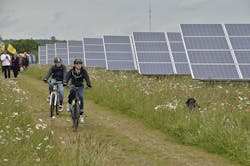Westmill Solar Co-operative
Credit: MrRenewables
Microgrids, community solar, rooftop solar, LEDs, smart thermostats, electric vehicles are capturing the collective imagination. Why?
They are all local energy. They give communities, households and businesses the ability to manipulate their energy in ways they cannot under the old central grid model. We can save it with LEDs, green it with solar, secure it with microgrids.
Meanwhile, plug-in electric vehicles open the door for the average you and me to eventually not only escape the politically-fraught and volatile pricing of the international oil market, but also become a kind of participant in electric markets.
Yes, these technologies also are clean, efficient, smart, low carbon, and all the other reasonable and good things that their publicists emphasize. And in many cases, the technology prices are falling.
But something bigger is afoot here.
Buying trends are rarely based on logic, altruism or even necessarily economics. An idea wins when it captures the emotional imagination. Like the local food movement, local energy seems intuitively right to the consumer.
Or as Pat Corrigan, an Elster vice president, said in a recent interview about energy storage, “A lot of technology progress is about faith. If people have faith that it is going to happen, it is more likely to move forward.”
Put another way, win public imagination and those with clout are more apt to make the market happen: the policymakers and investors.
Local energy enters 2015 with the public imagination captured and the policymakers and investors starting to move (or already active with some of these technologies, like solar).
Consider the pace of progress described by analysts.
- Residential solar grew 58 percent in the third quarter of 2014, continuing a trend of growth in 18 out of the previous 19 quarters, according to the third quarter report by the Solar Energy Industries Association and GTM Research.
- Even more interesting, the report foresees home solar soon outpacing the non-residential segment in annual installations.
- Navigant Research sees smart thermostats becoming a $146.9 million industry in 2014 to $2.3 billion in 2023, a boon for home energy efficiency.
- Businesses and institutions are ramping up combined heat and power (CHP) installations. Navigant Research forecasts worldwide revenue growing from $19.7 billion annually in 2013 to $29.8 billion in 2023.
Microgrids, our favorite topic here, are the big tent of the local energy movement. Microgrids use all and any of these technologies in various configurations. Transparency Market Research forecasts that the 3.6 GW of microgrid capacity operating in 2013 will grow to 9.35 GW by 2020. An often-quoted Navigant Research report found that the market could exceed $40 billion by 2020, with much of the growth centered in the United States. More recently, Navigant sees investment reaching $155 billion within a decade for microgrid-enabling tech — generators, smart inverters, energy storage.
Many trends are spurring more use of local energy. A pivotal phenomenon is the falling prices for energy storage. A household, business, community solar array, or microgrid becomes less dependent on the central grid if it can store the energy created by its generators.
Further, in North America several key states and provinces…California, Connecticut, Massachusetts, New Jersey, New York, and Ontario are rolling out new distributed energy and microgrid pilot programs and policies that will kick-start local energy.
Market and regulation are coming together to make 2015 a year to watch for local energy.
The growth forecasts make local energy look like a done deal. Ofcourse, it’s not. Much can slow the progress — public policy delays, utility resistance, a lack of innovative financing, even the flip of public attention onto the next new, new thing.
MicrogridKnowledge.com covers the progress of the local energy movement, its opportunities, controversies, successes and failures. We encourage you to keep up on this news by subscribing to our newsletter (it’s free). And please add to the local energy discussion on our LinkedIn Group, Microgrid Knowledge.
About the Author
Elisa Wood
Editor-in-Chief
Elisa Wood is the editor and founder of EnergyChangemakers.com. She is co-founder and former editor of Microgrid Knowledge.
